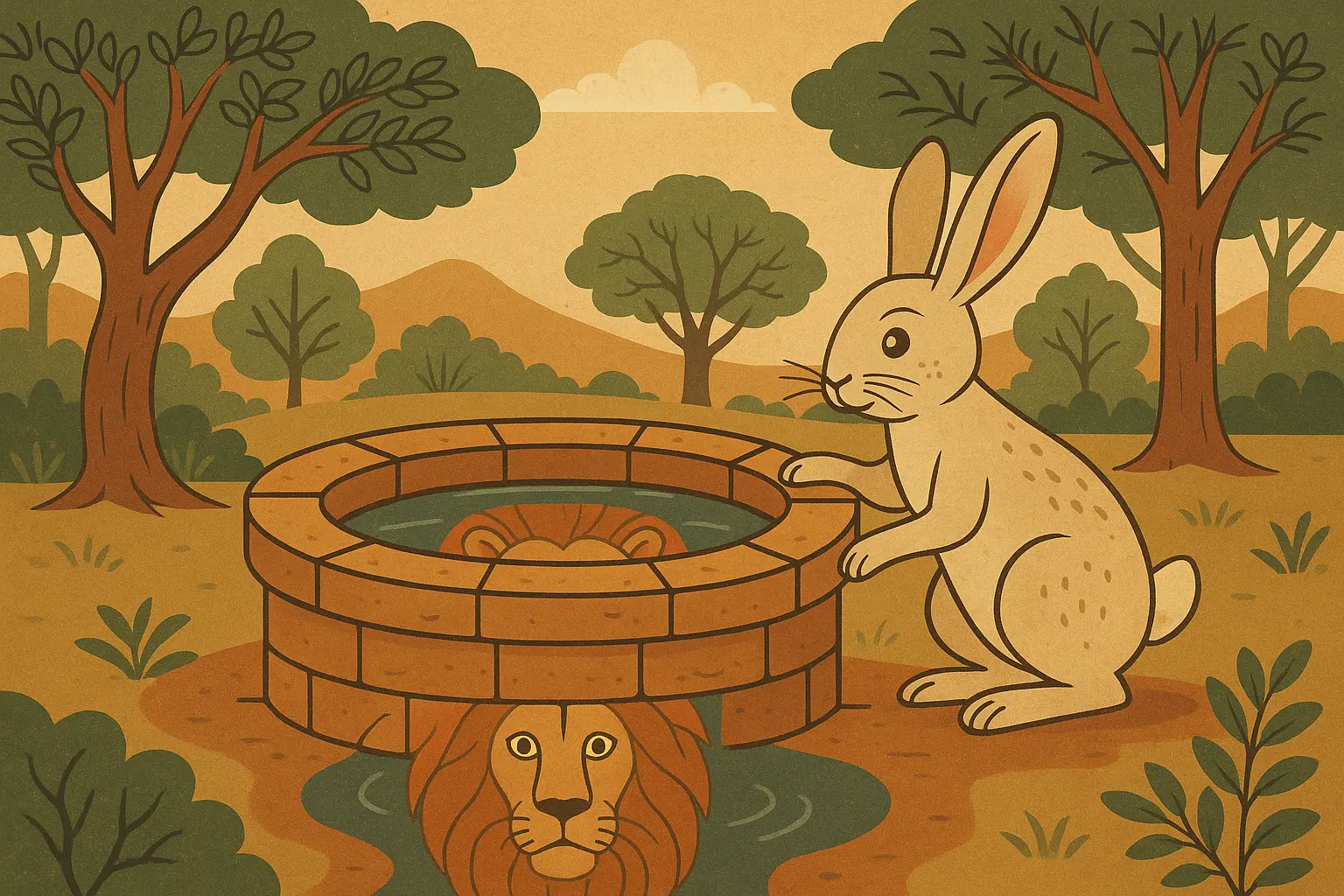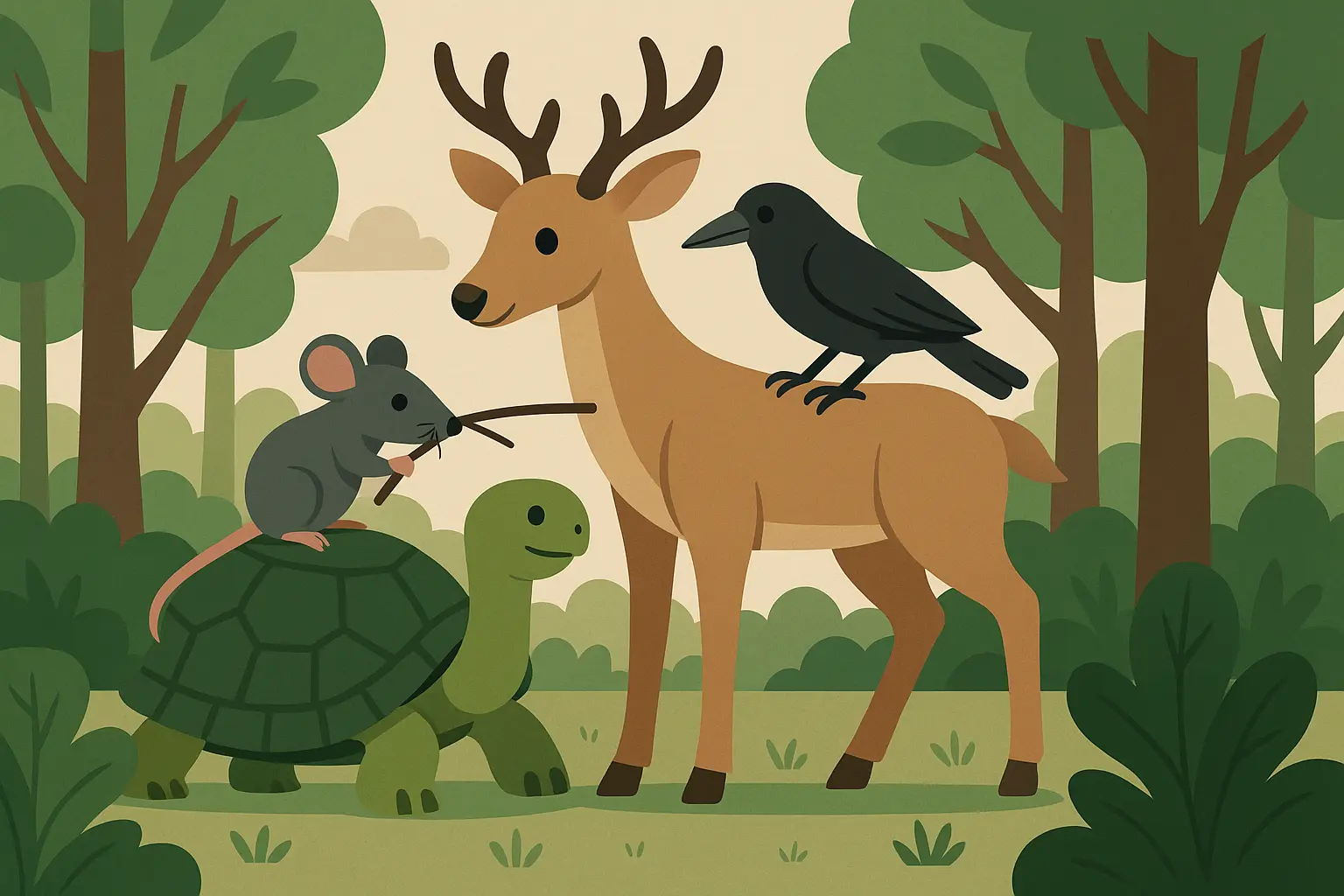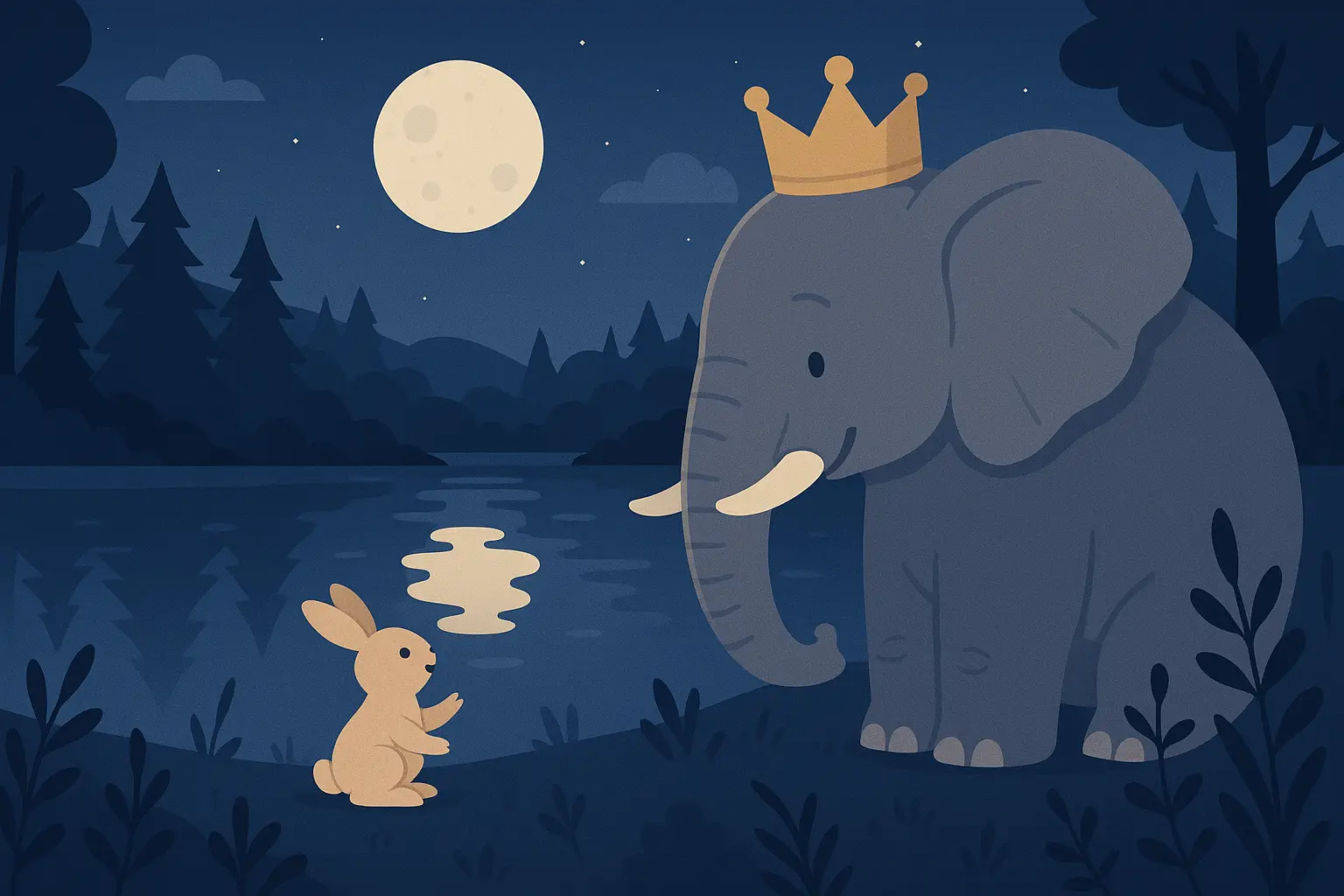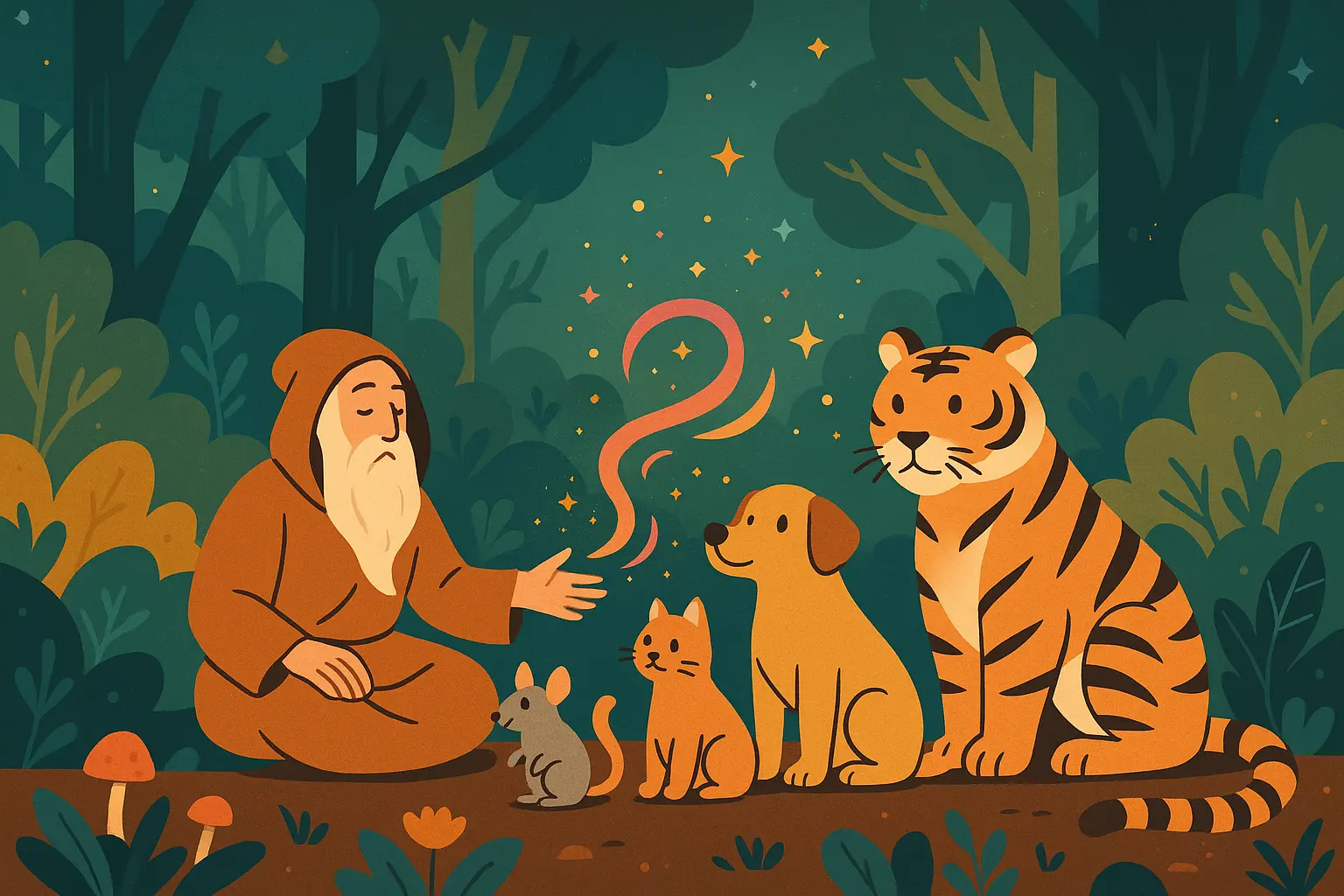My grandmother used to tell me stories when I was stressed about work. I thought they were just old tales until one particularly awful day with my micromanaging boss. She shared this story about a clever rabbit outsmarting a bully lion, and something clicked. Instead of getting defensive or emotional, I started thinking strategically – and it actually worked.
These Panchatantra stories have been around forever for good reason – they deal with the stuff we all face: backstabbing coworkers, fake friends, power-hungry bosses, and those moments when you have to choose between doing what’s easy and doing what’s right. These tales have been teaching life lessons for over 2500 years according to Sanskrit scholars, and they’re still relevant because human nature hasn’t changed much.
You’ll find practical wisdom that applies directly to the chaos of modern life – from dealing with office politics to figuring out who you can actually trust. These stories work the same way as various story theme examples – they stick in your head because they tap into universal human experiences.
What You Need to Know Before Diving In
Look, not all Panchatantra stories are created equal. Some are perfect for quick reference when you need immediate wisdom. Others require you to sit with them and really think. Here’s what I’ve learned about picking the right stories for the right situations.
When you’re wondering what are panchatantra stories and which ones actually matter, you need to understand that these ancient tales vary dramatically. Some will give you instant clarity, while others are like good wine – they get better with time and reflection.
The Real Deal vs. Watered-Down Versions
These stories date back thousands of years, which means there are a lot of sanitized, Disney-fied versions floating around. You want the ones that maintain their original punch – the ones that don’t shy away from the fact that sometimes good people get screwed over and bad people win in the short term.
The best versions respect where these stories came from without making you feel like you need a PhD in ancient Sanskrit to understand them. They preserve the essential wisdom while speaking in language that makes sense to us today.
Universal Truths That Actually Matter
The stories that have stuck around deal with the stuff we all face: How do you handle a boss who takes credit for your work? What do you do when your business partner starts acting shady? How do you tell the difference between real friends and people who are just using you?
Look for stories that make you think “Oh crap, I know someone exactly like that” or “I’ve been in this exact situation.” Those are the ones that’ll actually help you.
Simple vs. Complex Stories
Some stories are beautifully straightforward – bad thing happens to greedy person, lesson learned. Others have multiple layers and characters whose motivations aren’t immediately clear. Both have their place.
Quick reference stories work great when you need immediate perspective. Complex stories are better for when you have time to really dig in and think about the deeper patterns in your own life.
|
Story Type |
When to Use |
Best For |
|---|---|---|
|
Simple & Direct |
Need quick clarity |
Immediate decisions, teaching kids |
|
Complex & Layered |
Have time to think |
Understanding patterns, deep discussions |
|
Action-Focused |
Facing specific problems |
Workplace conflicts, relationship issues |
Real-World Application (The Most Important Part)
Here’s the thing – a story is only as good as your ability to actually use its wisdom. The best Panchatantra stories give you specific strategies you can try tomorrow. They help you recognize patterns before you get burned.
Take my friend Mike, who was getting played by his business partners. He kept making excuses for them until I shared the story about the camel who trusted the wrong animals. Suddenly he could see the pattern – his partners were setting him up to take the fall while they escaped with the profits. He got out before they could screw him over completely.
Know Your Audience
Some of these stories get pretty dark. The betrayal ones? They’re not bedtime stories for your six-year-old. But the friendship stories? Pure gold for teaching kids about loyalty and teamwork.
If you’re using these in a work context, stick to the leadership and strategy stories. If you’re trying to help a friend through a tough breakup, the trust and betrayal category has some hard truths that might help.

The 25 Stories That Actually Matter
I’ve organized these into categories based on the real problems they help you solve. Whether you’re dealing with a toxic workplace, trying to build better relationships, or just want to make smarter decisions, there’s wisdom here that actually works.
These aren’t just ancient stories – they’re practical guides for modern life. Each one addresses specific situations you’ve probably faced or will face soon.
Stories for Dealing with Bullies and Power Games
These five stories are your secret weapons for handling difficult people who think they can push you around. They teach you how to be strategic without becoming the villain yourself.
1. The Rabbit Who Outsmarted the Bully Lion
So there’s this rabbit who’s got to deal with a total bully of a lion. Instead of trying to fight him (which would be stupid), the rabbit figures out the lion’s weakness – his massive ego. The rabbit tricks him into thinking there’s another lion trying to steal his territory, and the idiot jumps into a well to fight his own reflection.
Why this matters: You don’t need to be the strongest person in the room. You just need to be the smartest. Find their weakness and use it.

2. The Monkey and the Backstabbing Friend
A monkey befriends a crocodile and shares his food every day. Then the crocodile’s wife gets jealous and demands her husband bring home the monkey’s heart for dinner. When the crocodile reluctantly tries to kill his friend, the monkey keeps his cool and tricks his way out by claiming he left his heart back in the tree.
Why this matters: Sometimes people you trust will turn on you. When it happens, don’t panic. Stay calm and think your way out.
3. The Guy Who Got Gaslighted by Three Thieves
A man is carrying a valuable goat when three thieves decide to steal it. They spread out along his path, and each one separately tells him he’s carrying a dog, not a goat. After hearing it three times, the guy starts doubting himself and abandons the goat. The thieves win.
Why this matters: When three different people tell you the same thing, it doesn’t automatically make it true. Sometimes it just means they’re all in on it together. Trust your own judgment.
4. The Lion Who Learned to Value Small Favors
A mighty lion spares a tiny mouse who promises to help him someday. Everyone laughs – what could a mouse do for a lion? Later, hunters trap the lion in nets, and guess who gnaws through the ropes to free him? The little mouse.
Why this matters: Don’t write people off because they seem unimportant today. You never know who might be in a position to help you tomorrow.
5. The Tortoise Who Couldn’t Keep His Mouth Shut
A talkative tortoise convinces two swans to carry him to a new pond. The plan is simple – he holds a stick in his mouth while they hold the ends. But when people below start commenting on the weird sight, the tortoise can’t resist opening his mouth to respond. He falls and dies.
Why this matters: Sometimes the hardest part of a plan is sticking to it when you want to show off or prove you’re right.
Stories About Real Friendship and Fake People
These five stories help you figure out who’s actually got your back and who’s just using you. They’re goldmines for understanding relationship dynamics.
6. The Four Unlikely Best Friends
A deer, crow, mouse, and tortoise become best friends despite being totally different. When hunters trap the deer, each friend uses their unique skills – the crow scouts from above, the mouse chews through ropes, and the tortoise provides the strategy. Together, they pull off an impossible rescue.
Why this matters: The best teams aren’t made of people who are all the same. Different strengths make you stronger together.

7. The Jackal Who Was Afraid of Nothing
A hungry jackal hears this terrifying sound in an abandoned battlefield. Instead of running away, he investigates and finds out it’s just an empty drum being hit by branches in the wind. His fear was completely made up.
Why this matters: Half the stuff we’re afraid of is just noise. Do your homework before you panic.
8. The Kid Who Lied About the Iron Beam
A merchant’s son borrows money using his dad’s iron beam as collateral. When he can’t pay back the loan, he claims mice ate the iron beam. The lender knows this is impossible but plays along. He invites the kid to dinner, then hides the kid’s son and claims a hawk flew away with the boy.
Why this matters: Lie to someone, and they’ll lie right back. Dishonesty creates a cycle that gets uglier and uglier.
9. The Jackal Who Pretended to Be Special
A jackal accidentally falls into blue dye and emerges bright blue. He convinces all the forest animals that he’s some divine creature sent to rule them. For a while, he’s living the dream. But when he hears other jackals howling, he instinctively howls back, and everyone realizes he’s just a regular jackal.
Why this matters: Fake it till you make it only works if you actually make it. Eventually, your true nature shows through.
10. The Mongoose Who Died a Hero
A farmer has a mongoose to protect his baby from snakes. One day he comes home to find blood on the mongoose’s mouth and assumes it attacked his child. In a rage, he kills the mongoose. Only then does he see the dead snake nearby and realize the mongoose died protecting his baby.
Why this matters: Don’t make decisions when you’re angry and don’t have all the facts. You might destroy something precious.
Stories About Being Smart vs. Being Wise
These four stories show the difference between knowing stuff and actually understanding how the world works. They’re crucial for anyone who wants to make better decisions.
11. The Scholar Who Was Too Smart for His Own Good
A learned sage discovers how to bring dead people back to life. A jackal warns him not to resurrect this particular dead child because the kid was evil when alive. The sage ignores the warning because he’s so proud of his new power. The revived child grows up to terrorize the community.
Why this matters: Knowledge without wisdom is dangerous. Just because you can do something doesn’t mean you should.
12. The Man Who Got Advice from a Thief and a Ghost
A guy gets conflicting advice about hidden treasure from a thief and a ghost. Through careful observation, he figures out how to tell the difference between self-serving advice and genuine help by understanding each advisor’s motivations.
Why this matters: Always ask yourself what the person giving you advice has to gain. Their motivations matter more than their credentials.
13. The Donkey in Designer Clothes
A donkey finds a lion’s skin and wears it to get respect from other animals. It works great until he runs into his old master and instinctively brays. Game over – everyone sees through the disguise.
Why this matters: You can’t fake competence forever. Eventually, you have to deliver, and that requires actual skills, not just good packaging.
14. The Rabbit Who Negotiated with Elephants
When a herd of elephants threatens to destroy a rabbit community by using their sacred lake, one clever rabbit approaches the elephant king. He convinces the king that the moon goddess is angry about the elephants polluting her waters, using the moon’s reflection in the disturbed water as “proof.”
Why this matters: Sometimes you can solve problems by understanding what the other person believes and values, rather than trying to overpower them.

Stories About Trust and Getting Burned
These four stories are tough but necessary. They deal with betrayal, broken promises, and the hard truth that not everyone deserves your trust.
15. The Camel Who Trusted the Wrong Friends
A camel trusts a jackal and crow who promise to help him cross a river to reach a sugarcane field. Once there, the smaller animals eat quickly and then make noise to alert farmers, leaving the slower camel to get caught and beaten while they escape safely.
Why this matters: Before you trust someone, make sure they have skin in the game. If they can bail out easily while you get stuck with the consequences, watch out.
16. The Crow Who Got Creative Revenge
A snake keeps eating a crow’s babies from their nest. The crow can’t fight the snake directly, so he gets creative. He steals the queen’s necklace and drops it in the snake’s hole. When the king’s guards come looking for the jewelry, they kill the snake to get it back.
Why this matters: When you can’t win with brute force, use strategy. Sometimes the best revenge is letting someone else do your dirty work.
17. The Ungrateful Human
A man falls into a pit with a tiger, snake, and monkey. A passing traveler helps rescue all of them. The animals are grateful and offer to help their rescuer in the future. The human? He falsely accuses his rescuer of theft the next time they meet.
Why this matters
Why this matters: Animals are predictable – humans can be worse than wild beasts. Don’t assume gratitude will last forever.
18. The Tiger Who Couldn’t Change His Nature
A kind man frees a tiger from a cage, but the tiger immediately threatens to eat him, claiming it’s just his nature. When other animals are consulted, most agree that while the tiger’s behavior is ungrateful, it’s also completely predictable.
Why this matters: When someone shows you who they are, believe them. Setting boundaries isn’t mean – it’s necessary.

Stories About How Greed and Shortcuts Backfire
These four stories are wake-up calls for anyone tempted by get-rich-quick schemes or shortcuts that seem too good to be true.
19. The Jackal Who Got His Head Stuck
A jackal finds a pot with leftover food and sticks his head inside to eat every last bit. His head gets stuck in the narrow opening, and he wanders around blindly until villagers kill him, thinking he’s some kind of monster.
Why this matters: Greed makes you stupid. When you’re so focused on grabbing everything you can, you lose sight of the bigger picture and the risks you’re taking.
20. The Frog King Who Made a Deal with the Devil
A frog king gets angry with his relatives and makes a deal with a serpent to eliminate his enemies. The serpent agrees and starts eating the king’s rivals. Eventually, having consumed all the other frogs, the serpent turns on the king himself.
Why this matters: When you use destructive forces against others, they usually end up destroying you too. Toxic tactics have a way of coming back around.
21. The Donkey Who Played Dress-Up
A washerman disguises his donkey as a tiger to scare people and steal their food at night. It works until the donkey hears other donkeys and instinctively brays in response. The villagers discover the trick and kill the animal.
Why this matters: You can fool people for a while, but your true nature always shows through eventually. Build real value instead of relying on deception.
22. The Bird Who Became a Prisoner of Its Own Gift
A unique bird produces golden droppings, making it incredibly valuable. When humans discover this ability, they capture the bird and keep it caged to harvest its gold. The bird’s amazing talent becomes the source of its misery.
Why this matters: Sometimes your greatest strength can become your biggest weakness if you don’t manage it properly. Success without boundaries can trap you.
Stories About Planning vs. Actually Doing Stuff
These three stories focus on the gap between having great ideas and actually executing them. They’re essential for anyone who’s ever had a brilliant plan that fell apart in reality.
23. The Mice Who Had a Perfect Plan
A group of mice are terrorized by a cat and hold a meeting to solve their problem. After much discussion, they come up with the perfect solution: put a bell around the cat’s neck so they’ll always know when it’s coming. Everyone agrees it’s brilliant until an old mouse asks, “Okay, but who’s actually going to put the bell on the cat?” Dead silence.
Why this matters: There’s a huge difference between identifying solutions and implementing them. Always ask “who’s going to do the hard part?” before you get too excited about any plan.
24. The Wife Who Tested Her Husband’s Love
A weaver’s wife decides to test how much her husband loves her by pretending to be dead. Her plan backfires spectacularly when her grief-stricken husband, believing she’s really gone, makes decisions that permanently damage their relationship and trust.
Why this matters: Testing relationships through manipulation usually damages them more than honest communication would. If you want to know something, just ask.
25. The Mouse Who Got Magical Makeovers
A kind hermit finds a mouse and uses magic to transform it into increasingly powerful forms – first a cat, then a dog, then a tiger. But no matter what it looks like on the outside, the mouse keeps its fearful, timid nature.
Why this matters: Core personality traits don’t change just because circumstances do. You can change someone’s title or give them new responsibilities, but their fundamental character usually stays the same.

Which Stories Actually Work Best
Look, some of these stories are better than others depending on what you’re dealing with. Here’s what I’ve learned from using them in real situations:
For workplace drama: The leadership and power game stories work best. They teach you how to handle difficult people without becoming one yourself.
For relationship problems: The friendship stories are gold, especially “The Four Friends” for understanding team dynamics and “The Loyal Mongoose” for not making decisions when you’re angry.
For business decisions: The trust and betrayal stories are brutal but necessary. They’ll help you spot red flags before you get burned.
For personal growth: The wisdom vs. intelligence stories force you to think about the difference between being smart and being wise.
Some of these stories are pretty heavy. The betrayal ones aren’t exactly uplifting, but they’re incredibly useful for understanding human nature. The consequence stories can be depressing, but they might save you from making expensive mistakes.
The strategic thinking stories have the highest practical value if you’re in any kind of leadership role. They teach you how to solve problems creatively instead of just throwing money or force at them.
How to Actually Use These Stories
These aren’t just entertaining tales – they’re practical tools for better decision-making. Here’s how to make them work for you instead of just reading them once and forgetting about them.
The key is recognizing the patterns these stories reveal before you’re in the middle of a crisis. Once you internalize these character types, you’ll start spotting them everywhere – the greedy jackal in your coworker who cuts corners, the loyal mongoose in your friend who always has your back, the blue jackal in that guy who’s clearly faking his expertise.
At Work
When you’re facing a difficult negotiation, think about “The Rabbit and the Lion.” Instead of trying to match your opponent’s power, look for their psychological weaknesses. Most bullies have fragile egos – use that.
If you’re building a team, “The Four Friends” is your blueprint. Don’t try to hire four versions of yourself. Get people with different strengths who complement each other.
Before you implement any plan, ask the mouse question: “Who’s actually going to bell the cat?” If nobody wants to do the hard part, your brilliant strategy is worthless.
Sarah from accounting used this approach when her team was falling apart. Instead of trying to make everyone work the same way, she figured out who was good at what – her detail person, her big picture person, her people person. Boom. Team fixed.
In Relationships
“The Loyal Mongoose” should be required reading for anyone in a relationship. When you’re angry and want to make accusations, stop. Get the full story first. You might be about to destroy something precious based on incomplete information.
When evaluating new friendships or business partnerships, think about “The Camel and His False Friends.” Do these people have aligned incentives with you, or can they bail out easily while you’re left holding the bag?
If someone’s trying to gaslight you like the three thieves with the goat, trust your own judgment. Just because multiple people are telling you the same thing doesn’t make it true – especially if they know each other.
Making Better Decisions
Before any major decision, run through the greed check: Am I being like the jackal who got his head stuck in the pot? Am I so focused on immediate gains that I’m ignoring obvious risks?
Use the wisdom vs. intelligence filter: Do I actually understand this situation, or am I just showing off my knowledge? The sage who could raise the dead was brilliant but ignored practical wisdom from a jackal.
When someone gives you advice, think about the thief and the ghost story. What does this person have to gain from the advice they’re giving you? Their motivations matter more than their credentials.
|
Situation |
Story to Remember |
Key Question to Ask |
|---|---|---|
|
Facing a bully |
The Rabbit and the Lion |
What’s their weakness? |
|
Building a team |
The Four Friends |
How do our different strengths complement each other? |
|
Someone seems too good to be true |
The Blue Jackal |
What happens when the pressure’s on? |
|
Tempted by a shortcut |
The Greedy Jackal |
What’s the real cost of this “opportunity”? |
|
Getting conflicting advice |
The Thief and the Ghost |
What does each advisor have to gain? |
Teaching Others
These stories work great for teaching kids about consequences without being preachy. The greed stories are perfect for helping them understand why shortcuts usually backfire.
For teenagers, the friendship stories help them navigate social drama and figure out who their real friends are versus who’s just using them.
In professional training, the leadership stories provide frameworks for handling difficult people and situations without resorting to power games or manipulation.
The beauty of these stories is that they work on multiple levels. Kids get the basic moral lessons, while adults can dig deeper into the psychology and strategy.
Modern Storytelling Meets Ancient Wisdom
What makes these Panchatantra stories so powerful is how they embed complex life lessons in memorable narratives. They work the same way powerful anecdote examples do in modern communication – they make abstract concepts concrete and unforgettable.
Whether you’re creating content for your business, developing training materials, or just want to communicate more effectively, understanding how these stories work gives you valuable insights into narrative construction and audience engagement.
Parents looking for meaningful bedtime content will find these moral tales complement bedtime stories for kids by providing educational value alongside entertainment, helping children develop critical thinking skills through engaging narratives.
The stories work because they’ve been refined over centuries to focus on universal human experiences rather than culture-specific details. They cut straight to the psychological and emotional truths that transcend time and geography.
Understanding how these stories structure their lessons can improve your own communication skills, whether you’re presenting to colleagues, teaching your children, or simply trying to make a point more memorably in conversation.


Start Small, Think Big
Here’s the thing – you don’t need to memorize all 25 stories. Even my grandmother only had a few favorites that she’d return to again and again. Start with just one story that speaks to your current situation. Read it, think about it, and try applying the lesson this week.
Maybe you’re dealing with a difficult coworker right now. Try the rabbit and lion approach – instead of getting into a power struggle, figure out what makes them tick and use strategy instead of force.
Or maybe you’re building a new team. Think about the four friends story and focus on getting people with different strengths rather than trying to hire four versions of yourself.
The power of these stories isn’t in collecting them like Pokemon cards. It’s in deeply understanding a few key ones that apply to your life right now. Once you’ve internalized one or two, you’ll start seeing the patterns everywhere.
These ancient tales remind us that the fundamental challenges of human life haven’t changed much. The specific contexts are different – we have smartphones instead of talking animals – but the underlying dynamics of trust, power, wisdom, and consequences continue shaping our daily experiences.
The people who wrote these stories thousands of years ago were dealing with the same basic problems you face today: How do you handle betrayal? How do you build real friendships? How do you make good decisions when you don’t have all the information? How do you deal with people who have more power than you?
They figured out some pretty good answers. The least we can do is pay attention.



Add comment